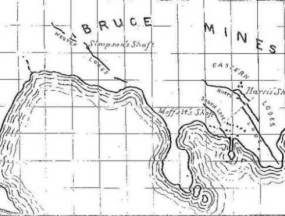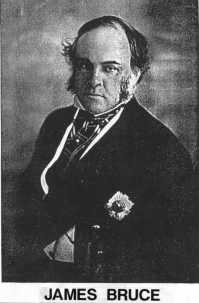Named after James Bruce, who was appointed as Governor General of Canada in 1846, the town of Bruce Mines (otherwise known as the “Jewel of Lake Huron”), was first established in that same year as a copper mining area by John Keating, Indian Agent, after exploration with Arthur Rankin, a land surveyor. Keating began mining in December, employing skilled Cornish miners who had recently emigrated from England. The Huron & St. Mary’s Copper Co. was formed to manage the miners.
The Bruce Mines changed ownership several times between 1847 and 1944, when they were decommissioned. Flooding and cave-ins in 1876 ended the 30-year period of active mining history. In the 1870's, agriculture and logging prospered in the wake of uncertainty with the mines. The Township of Plummer Additional became incorporated in 1891 while Northern Ontario's first town, the Town of Bruce Mines was officially incorporated in 1903.
Several attempts to re-open the mines in the early 1900's saw only limited success by Mond Nickel, who shipped the quartz-copper flux ore to Sudbury. Mond Nickel shut down the Bruce Mines in 1921.
The mines were decommissioned in 1944 and forestry activities have declined, but agriculture, aggregate extraction and tourism continue as the main economic activities in the area. The Township of Plummer Additional depends on Bruce Mines and other urban centres for most of its commercial and community services.
Single jacking on upper holes was tiring on the hand and arm. To lessen the fatigue, old timers used a thong on the hammer handle, which permitted the opening and relaxing of the hand on the back stroke.
Additional Information
To find out more about Mining in our Area go to Bruce Mines: A History of Copper. There you can view over 180 historical images and read supporting narratives.
First Map of Bruce Mines:
This map was the first map of Bruce Mines, published in 1849 by William Edward Logan, first director of the Geological Survey of Canada.

History of Mining in Bruce Mines and District:
1846
-
John Keating, Indian Agent, was informed by the local native people of the location of copper minerals in the area. Keating and Arthur Rankin, a land surveyor, explored the area.
-
In September James Cuthbertson, a Montreal merchant, applied for a mining license, which was declined due to a government moratorium. Cuthbertson purchased the land and Keating obtained the location west of Cuthbertson.
-
Keating began mining in December, employing skilled Cornish miners who had recently emigrated from England.
-
The Huron & St. Mary's Copper Co. was formed to manage the miners. Bruce Mines was named after James Bruce, Governor General of Canada.

1847
-
On July 1st, the shipment of 10% copper was sold in Boston @ $25 per ton.
-
The Montreal Mining Co. bought the Cuthbertson location. Refining furnaces, steam engines and concentrating mills were erected and mining veins dug to deeper levels.
1853
-
The Montreal Mining Co. leased the western half of the Cuthbertson location to the Wellington Copper Mine Company of England
-
The Wellington Copper Mine became the West Canada Copper Mining Co., developing the Cuthbertson location.
-
Both the Montreal Mining Co. and the West Canada Co. sold shipments at the auctions in England.
1865
-
The West Canada Copper Mining Co. bought the remaining Cuthbertson location from the Montreal Mining Co. and leased the Keating location.
1876
-
Floods and cave-ins ended the 30-year period of local mining history.
1900s
-
Unsuccessful attempts at reopening the mines were made by the Bruce Copper Mines Ltd, the Copper Mining and Smelting Co. of Ontario and the Bruce Mines Ltd.
1915
-
The Mond Nickel purchased the mines, shipping ore to Sudbury as quartz-copper flux ore.
1921
-
In February the Mond Nickel Co. shut down the Bruce Mines.
